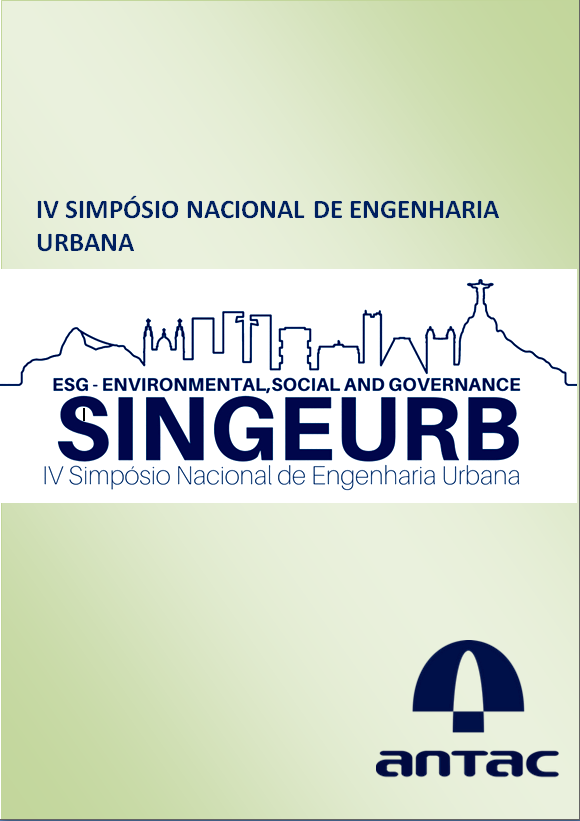REVISÃO SISTEMÁTICA DA LITERATURA (RST): SELEÇÃO DE INDICADORES PARA CIDADES CIRCULARES
DOI:
https://doi.org/10.46421/singeurb.v4i00.3587Palavras-chave:
Cidade Circular, Economia Circular, IndicadoresResumo
Partindo-se de que as cidades apresentam ineficiências no uso de recursos, resultando em problemas de ordem social e ambiental, o conceito de cidades circulares emerge com abordagem para repensar e edificar espaços urbanos. Nesse contexto, a economia circular vem se destacando devido à capacidade de redefinir a noção de crescimento econômico, possibilitando mais eficiência administrativa e maior sustentabilidade na disponibilidade de recursos. Essa área se revela intrincada, carente de documentação, abrindo oportunidades para investigações no âmbito nacional, visando fomento na adoção de princípios e práticas ligados à economia circular. Nesse cenário, o estudo realizou uma revisão bibliométrica identificando quais indicadores de circularidade devem ser monitorados para a realidade brasileira. Foi utilizado um método composto por revisão sistemática da literatura e coleta de dados empíricos por meio de entrevistas com especialistas teóricos e práticos nos campos da economia circular e do planejamento urbano, na cidade do Rio de Janeiro. Os indicadores identificados na revisão sistemática da literatura foram categorizados de acordo com suas implicações ambientais, sociais e econômicas, a fim de torná-los aplicáveis à realidade brasileira. A investigação forneceu informações para tomadores de decisão e atores urbanos sobre como colaborar no desenvolvimento de iniciativas voltadas para o estabelecimento de cidades circulares.
Referências
BECCARELLO, M.; DI FOGGIA, G. Sustainable Development Goals Data-Driven Local Policy: Focus on SDG 11 and SDG 12. Administrative Sciences, v. 12, n. 4, 2022.
BÎRGOVAN, A. L. et al. How Should We Measure? A Review of Circular Cities Indicators. International Journal of Environmental Research and Public Health, v. 19, n. 9, p. 5177, 24 abr. 2022.
BOCKEN, N. M. P. et al. Product design and business model strategies for a circular economy. Journal of Industrial and Production Engineering, v. 33, n. 5, 2016.
BOERI, A. et al. Circular City: A Methodological Approach for Sustainable Districts and Communities. WIT Transactions on the Built Environment. Anais...WITPress, 2 out. 2018. Disponível em: <http://library.witpress.com/viewpaper.asp?pcode=ARC18-007-1>
BULKELEY, H. et al. Urban living laboratories: Conducting the experimental city? European Urban and Regional Studies, v. 26, n. 4, 2019.
DE JONG, M. et al. Sustainable-smart-resilient-low carbon-eco-knowledge cities; Making sense of a multitude of concepts promoting sustainable urbanization. Journal of Cleaner Production, v. 109, 2015.
ELLEN MACARTHUR FOUNDATION. DELIVERING THE CIRCULAR ECONOMY A TOOLKIT FOR POLICYMAKERS. Londres: [s.n.]. Disponível em: <https://emf.thirdlight.com/file/24/neVTuDFno5ajUene-man5IbBE/Delivering%20the%20circular%20economy%3A%20a%20toolkit%20for%20policymakers.pdf>. Acesso em: 11 jun. 2023.
ELLEN MACARTHUR FOUNDATION. Circularity Indicators: an approach to measuring circularity - methodology. [s.l: s.n.]. Disponível em: <http://www.ellenmacarthurfoundation.org/circularity-indicators/.>.
FEIFERYTĖ-SKIRIENĖ, A.; STASIŠKIENĖ, Ž. Seeking Circularity: Circular Urban Metabolism in the Context of Industrial Symbiosis. Sustainability, v. 13, n. 16, p. 9094, 13 ago. 2021.
FERRONATO, N. et al. Introduction of the circular economy within developing regions: A comparative analysis of advantages and opportunities for waste valorization. Journal of Environmental Management, v. 230, 2019.
GENG, Y. et al. Implementing China’s circular economy concept at the regional level: A review of progress in Dalian, China. Waste Management, v. 29, n. 2, 2009.
GENG, Y. et al. Towards a national circular economy indicator system in China: An evaluation and critical analysis. Journal of Cleaner Production, v. 23, n. 1, 2012.
GHISELLINI, P.; CIALANI, C.; ULGIATI, S. A review on circular economy: The expected transition to a balanced interplay of environmental and economic systems. Journal of Cleaner Production, v. 114, 2016.
GIAMBONA, F.; VASSALLO, E. Composite Indicator of Social Inclusion for European Countries. Social Indicators Research, v. 116, n. 1, 2014.
GILJUM, S. et al. A comprehensive set of resource use indicators from the micro to the macro level. Resources, Conservation and Recycling, v. 55, n. 3, 2011.
GRAVAGNUOLO, A.; ANGRISANO, M.; FUSCO GIRARD, L. Circular Economy Strategies in Eight Historic Port Cities: Criteria and Indicators Towards a Circular City Assessment Framework. Sustainability, v. 11, n. 13, p. 3512, 26 jun. 2019.
HANNON, E.; KUHLMANN, M.; THAIDIGSMANN, B. Developing products for a circular economy. Disponível em: <https://www.mckinsey.com/capabilities/sustainability/our-insights/developing-products-for-a-circular-economy#/>. Acesso em: 11 jun. 2023.
KONONENKO, O.; DRONOVA, O. Urban Metabolism as a Background for the Development of Circular Cities in Ukraine. Ukrainian Geographical Journal, v. 2022, n. 1, p. 36–46, 2022.
LUCERTINI, G.; MUSCO, F. Circular Urban Metabolism Framework. One Earth, 2020.
MERLI, R.; PREZIOSI, M.; ACAMPORA, A. How do scholars approach the circular economy? A systematic literature review. Journal of Cleaner Production, 2018.
MORAGA, G. et al. Circular economy indicators: What do they measure? Resources, Conservation and Recycling, v. 146, p. 452–461, jul. 2019.
NURDIANA, J.; FRANCO-GARCIA, M. L.; HELDEWEG, M. A. How Shall We Start? The Importance of General Indices for Circular Cities in Indonesia. Sustainability, v. 13, n. 20, p. 11168, 10 out. 2021.
POTTING, J. et al. Circular Economy: What We Want to Know and Can Measure-System and Baseline Assessment for Monitoring the Progress of the Circular Economy in the NetherlandsPBL Netherlands Environmental Assessment Agency: Policy Brief. [s.l: s.n.].
PREFEITURA DA CIDADE DO RIO DE JANEIRO (PCRJ). Plano de Desenvolvimento Sustentável e Ação Climática da Cidade do Rio de Janeiro. Rio de Janeiro: [s.n.]. Disponível em: <http://www.rio.rj.gov.br/dlstatic/10112/12937849/4327050/PDS_COMPLETO_0406.pdf>. Acesso em: 12 jun. 2023.
SANTAGATA, R. et al. Assessing the sustainability of urban eco-systems through Emergy-based circular economy indicators. Ecological Indicators, v. 109, p. 105859, 1 fev. 2020.
SHMELEV, S. Multidimensional Sustainability Assessment for Megacities. Em: [s.l: s.n.].
SHMELEV, S. E.; SHMELEVA, I. A. Multidimensional sustainability benchmarking for smart megacities. Cities, v. 92, 2019.
WBCSD. Water Circularity Metric: Tool application and guidance note. Geneva, Switzerland: [s.n.]. Disponível em: <https://www.wbcsd.org/contentwbc/download/12130/182099/1>. Acesso em: 9 maio. 2022.

